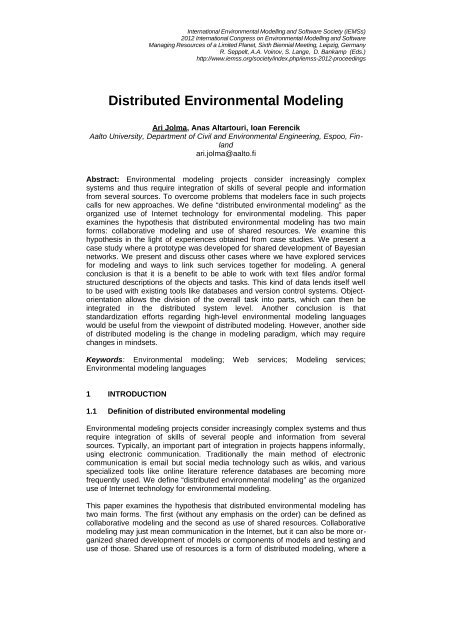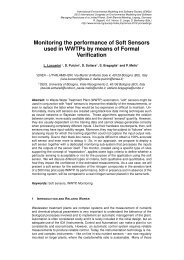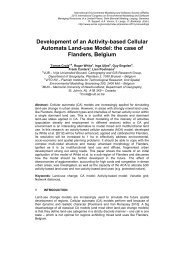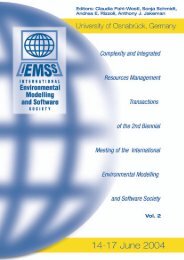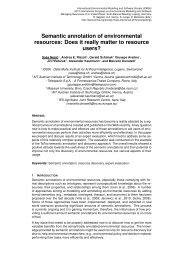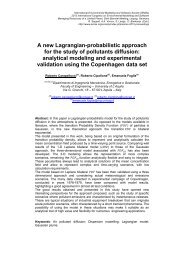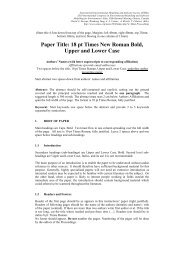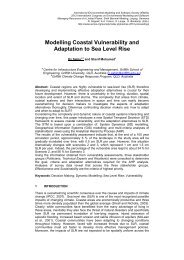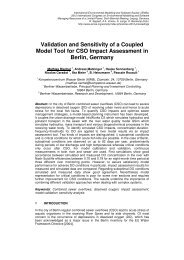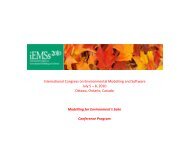Paper details - International Environmental Modelling and Software ...
Paper details - International Environmental Modelling and Software ...
Paper details - International Environmental Modelling and Software ...
Create successful ePaper yourself
Turn your PDF publications into a flip-book with our unique Google optimized e-Paper software.
<strong>International</strong> <strong>Environmental</strong> <strong>Modelling</strong> <strong>and</strong> <strong>Software</strong> Society (iEMSs)<br />
2012 <strong>International</strong> Congress on <strong>Environmental</strong> <strong>Modelling</strong> <strong>and</strong> <strong>Software</strong><br />
Managing Resources of a Limited Planet, Sixth Biennial Meeting, Leipzig, Germany<br />
R. Seppelt, A.A. Voinov, S. Lange, D. Bankamp (Eds.)<br />
http://www.iemss.org/society/index.php/iemss-2012-proceedings<br />
Distributed <strong>Environmental</strong> Modeling<br />
Ari Jolma, Anas Altartouri, Ioan Ferencik<br />
Aalto University, Department of Civil <strong>and</strong> <strong>Environmental</strong> Engineering, Espoo, Finl<strong>and</strong><br />
ari.jolma@aalto.fi<br />
Abstract: <strong>Environmental</strong> modeling projects consider increasingly complex<br />
systems <strong>and</strong> thus require integration of skills of several people <strong>and</strong> information<br />
from several sources. To overcome problems that modelers face in such projects<br />
calls for new approaches. We define “distributed environmental modeling” as the<br />
organized use of Internet technology for environmental modeling. This paper<br />
examines the hypothesis that distributed environmental modeling has two main<br />
forms: collaborative modeling <strong>and</strong> use of shared resources. We examine this<br />
hypothesis in the light of experiences obtained from case studies. We present a<br />
case study where a prototype was developed for shared development of Bayesian<br />
networks. We present <strong>and</strong> discuss other cases where we have explored services<br />
for modeling <strong>and</strong> ways to link such services together for modeling. A general<br />
conclusion is that it is a benefit to be able to work with text files <strong>and</strong>/or formal<br />
structured descriptions of the objects <strong>and</strong> tasks. This kind of data lends itself well<br />
to be used with existing tools like databases <strong>and</strong> version control systems. Objectorientation<br />
allows the division of the overall task into parts, which can then be<br />
integrated in the distributed system level. Another conclusion is that<br />
st<strong>and</strong>ardization efforts regarding high-level environmental modeling languages<br />
would be useful from the viewpoint of distributed modeling. However, another side<br />
of distributed modeling is the change in modeling paradigm, which may require<br />
changes in mindsets.<br />
Keywords: <strong>Environmental</strong> modeling; Web services; Modeling services;<br />
<strong>Environmental</strong> modeling languages<br />
1 INTRODUCTION<br />
1.1 Definition of distributed environmental modeling<br />
<strong>Environmental</strong> modeling projects consider increasingly complex systems <strong>and</strong> thus<br />
require integration of skills of several people <strong>and</strong> information from several<br />
sources. Typically, an important part of integration in projects happens informally,<br />
using electronic communication. Traditionally the main method of electronic<br />
communication is email but social media technology such as wikis, <strong>and</strong> various<br />
specialized tools like online literature reference databases are becoming more<br />
frequently used. We define “distributed environmental modeling” as the organized<br />
use of Internet technology for environmental modeling.<br />
This paper examines the hypothesis that distributed environmental modeling has<br />
two main forms. The first (without any emphasis on the order) can be defined as<br />
collaborative modeling <strong>and</strong> the second as use of shared resources. Collaborative<br />
modeling may just mean communication in the Internet, but it can also be more organized<br />
shared development of models or components of models <strong>and</strong> testing <strong>and</strong><br />
use of those. Shared use of resources is a form of distributed modeling, where a
A. Jolma et al. / Distributed environmental modeling<br />
modeler uses modeling resources like data, ontologies, <strong>and</strong> computational tools<br />
that are available on the Internet.<br />
In an earlier paper (Jolma <strong>and</strong> Karatzas 2011) a first look was given at the concept<br />
<strong>and</strong> it was considered from the viewpoint of modeling workflows <strong>and</strong> software<br />
architectures that support them.<br />
1.3 Aims <strong>and</strong> scope of this paper<br />
This paper aims to analyze the two forms of distributed environmental modeling by<br />
presenting cases where we are currently developing prototypes. The prototype,<br />
which is used as an example of collaborative modeling, was initially developed<br />
within a project focusing on risk analysis in environmental management in the Gulf<br />
of Finl<strong>and</strong> (the IBAM research project). The main objective of IBAM was to create<br />
an environmental decision model <strong>and</strong> deliver the results to the decision makers.<br />
The requirements of distributed modeling, i.e., to support the collaborative creation<br />
<strong>and</strong> use of Bayesian networks as integrated models of environmental-social<br />
systems, were added to what was initially a platform for model delivery. The prototypes<br />
which exemplify the use of shared resources are developed in various<br />
projects, but mainly in one which aims to create a modeling client for distributed<br />
<strong>and</strong> st<strong>and</strong>ards-based services (or services, which could become st<strong>and</strong>ards-based).<br />
In the case of modeling clients the existing st<strong>and</strong>ards are usually developed within<br />
OGC (Open Geospatial Consortium). OGC is an international industry consortium<br />
which runs a consensus process to develop publicly available interface st<strong>and</strong>ards,<br />
especially for web services. OGC has developed, among others, st<strong>and</strong>ards for<br />
environmental sensors, geospatial data, <strong>and</strong> for a web processing service. The<br />
st<strong>and</strong>ards typically define services for workflows that include steps of type “get<br />
capabilities of this service”, “get a data resource”, “get more information about a<br />
location”.<br />
2 METHODS OF DISTRIBUTED ENVIRONMENTAL MODELING<br />
2.1 Collaborative development of environmental models<br />
Collaborative development is a practical method to develop integrated models.<br />
Jakeman (2010) discussed integration in modeling in a presentation he gave at an<br />
OGC technical meeting. According to him, integration can be done along several<br />
dimensions: issues, geographic features, drivers, disciplines, stakeholders,<br />
approaches, <strong>and</strong> tools. Collaborative development can thus mean involv ing<br />
experts that cover this integration space. Each expert needs a meaningful way to<br />
make a contribution into the integrated whole. Collaboration calls for methods to<br />
link a particular input into the whole.<br />
Within the above mentioned presentation Jakeman also listed approaches for integrated<br />
modeling. According to him these are systems dynamics, Bayesian<br />
networks, coupling complex models, agent-based models, <strong>and</strong> hybrid expert<br />
systems. Of these Bayesian networks have arguably the best developed st<strong>and</strong>ards<br />
for model representation (XMLBIF, Cozman 1998), although that effort appears to<br />
have stalled. St<strong>and</strong>ardized model representation is important from the point of<br />
view of creating distributed systems in the same way as st<strong>and</strong>ardized data<br />
services. Coupling of complex models is the most difficult approach in this respect<br />
as it requires working installations of several complex models plus a technology to<br />
implement the coupling.<br />
The software engineering community has developed widely used <strong>and</strong> shared systems<br />
for collaborative development of software, the version control systems or<br />
source code management systems being the best example. In fact, these systems
A. Jolma et al. / Distributed environmental modeling<br />
are just as useful <strong>and</strong> usable in collaborative development of any objects that can<br />
be described with text.<br />
2.2 Use of distributed environmental modeling resources<br />
<strong>Environmental</strong> modeling requires both information <strong>and</strong> computational resources.<br />
Information resources provide data about the problem, geographical area in question,<br />
<strong>and</strong> knowledge. Computational resources are needed to process information<br />
into more useful forms. A lot of modeling involves interaction with information resources<br />
<strong>and</strong> computations where the goal is to specify modeling context, conceptualize<br />
the system, etc.<br />
Web services are applications, which allow direct interaction with other applications<br />
using st<strong>and</strong>ards-based protocols <strong>and</strong> interfaces (Alonso et al. 2004). Web<br />
services may deliver data or they may deliver data processing. In the first case the<br />
client of the service sends a detailed request, which the service interprets <strong>and</strong><br />
fetches, processes, formats, packages <strong>and</strong> finally sends the data that meets the<br />
request in content <strong>and</strong> form. In the latter case the client needs either to send data<br />
for the processing or inform the service how to obtain the input data, in addition to<br />
a detailed request. Before a client can send any detailed data or processing requests<br />
it needs to know what the service offers <strong>and</strong> even before that it needs to<br />
know about the service. This is the well-known “(how to) publish <strong>and</strong> find” problem.<br />
2.3 Collaborative platforms for environmental management<br />
Two broad classes of information systems are commonly used to aid environmental<br />
management. The first is decision support systems (DSSs), which are<br />
interactive systems designed to help managers to utilize data <strong>and</strong> models to solve<br />
unstructured problems (Gorry <strong>and</strong> Scott Morton 1971 , Turban <strong>and</strong> Aronson,<br />
2001). The second class of systems is communication systems.<br />
The decision that a DSS is built to support may be operational or it may be a<br />
strategic one. Some DSSs rely mostly on data or case descriptions while some<br />
DSSs rely on models. The model or models may represent the system in which<br />
the decision is embedded or they may represent the value structure of the decision<br />
maker. Regarding data, a requirement can be set to DSS to support the<br />
transformation of data into information <strong>and</strong> to knowledge. System models referred<br />
to above are computational tools that come out of natural sciences, operations<br />
research, artificial intelligence, <strong>and</strong> other domains. Particularly popular tools are<br />
simulation models, optimization models, representational models, <strong>and</strong> causal<br />
models. Characteristically, solving unstructured problems requires innovation,<br />
review of existing information, judgment, interaction, building confidence, learning,<br />
<strong>and</strong> other skills. Requirements of DSSs include general analysis capabilities,<br />
modeling, <strong>and</strong> integrated use of tools.<br />
<strong>Environmental</strong> communication can be defined as planned <strong>and</strong> strategic use of<br />
communication processes to support effective policy-making <strong>and</strong> project implementation<br />
geared towards environmental sustainability (Hamacher <strong>and</strong> Paulus,<br />
1999). Technological developments have supported transitions from broadcast<br />
type communication (one sender multiple receivers) to interactive communication<br />
(multiple senders <strong>and</strong> multiple receivers). Other transitions that are taking place<br />
include the emphasis from cognitive to experiential learning, from productorientation<br />
to process-orientation, from conflict positions to shared meaning, from<br />
distributive to integrative negotiations, <strong>and</strong> from compartmental knowledge to<br />
explicit treatment of complexity, uncertainty, <strong>and</strong> risk (Scharl, 2004 <strong>and</strong> references<br />
therein).
A. Jolma et al. / Distributed environmental modeling<br />
3 CASE: A DSS FOR INTEGRATED ENVIRONMENTAL MANAGEMENT<br />
The overall topic of the IBAM project was integrated Bayesian risk analysis of<br />
ecosystem management in the Gulf of Finl<strong>and</strong>. A research question in IBAM was<br />
how to support collaborative creation of an integrative model-based decision<br />
support tool that aims to deliver the research results to a wider audience.<br />
3.1 The ecosystem of the Gulf of Finl<strong>and</strong> <strong>and</strong> its management<br />
The Gulf of Finl<strong>and</strong> is one of the three gulfs in the Baltic Sea. It has a surface area<br />
of close to 30 000 km 2 <strong>and</strong> it is 400 km long <strong>and</strong> 70 to 130 km wide. It is relatively<br />
shallow with an average depth of 38 m <strong>and</strong> the maximum of 100 m. Close to 6<br />
million people live on its coast in cities like St Petersburg, Helsinki, <strong>and</strong> Tallinn.<br />
The drainage area of the gulf is approximately 420 000 km2 <strong>and</strong> cover Finnish,<br />
Russian, <strong>and</strong> Estonian soils. The Gulf was formed only after the last ice age. Due<br />
to a large influx of fresh water the salinity of the Gulf is very low <strong>and</strong> varies<br />
between 0.2 <strong>and</strong> 8.5 ‰. The Gulf is usually partly frozen from late November to<br />
late April, but complete freezing requires a cold winter. The northern Finnish coast<br />
of the Gulf is winding with abundant isl<strong>and</strong>s <strong>and</strong> skerries, while the southern Estonian<br />
coast is smooth <strong>and</strong> shallow with only a few larger isl<strong>and</strong>s. Several fish<br />
species live in the gulf <strong>and</strong> commercial fishing is carried out, herring fishery being<br />
the most important.<br />
Several ecological problems exist in the Gulf. Contaminants like dioxins <strong>and</strong><br />
methylmercury can be found from the area <strong>and</strong> for example the Finnish Food<br />
Safety Authority (Evira) recommends caution when eating herring or salmon from<br />
the Gulf. There are also radioactive materials in the sediments, originating mostly<br />
from the Tshernobyl accident. Nutrients entering the Gulf <strong>and</strong> in the sediments are<br />
high causing frequent algae blooms. Several alien species are invading the Baltic<br />
Sea <strong>and</strong> also the Gulf. The Baltic Sea Alien Species Database 1 lists 41 alien<br />
species that have been found in the Gulf of Finl<strong>and</strong>.<br />
Drivers or pressures on the ecology of the Gulf include, among others, climate<br />
change; pollution from agriculture, waste water, <strong>and</strong> other sources; overfishing;<br />
traffic, especially increasing transport of oil <strong>and</strong> petrochemicals; <strong>and</strong> development<br />
<strong>and</strong> construction.<br />
3.2 Designing a collaborative modeling platform for the Gulf of Finl<strong>and</strong><br />
The previous section attempts to highlight that the Gulf of Finl<strong>and</strong> is both a very<br />
active economic area with interest from a lot of people <strong>and</strong> many countries, <strong>and</strong><br />
environmentally a very diverse, vulnerable, <strong>and</strong> threatened area. There are several<br />
environmental issues concerning the Gulf <strong>and</strong> one of the main premises of the<br />
IBAM project was that an integrated risk analysis should be the basis of environmental<br />
management of the Gulf. A starting point for IBAM was to employ<br />
Bayesian network methodology for the integration <strong>and</strong> risk analysis.<br />
3.3 The IBAM DSS prototype<br />
The IBAM DSS prototype was developed using a relational database management<br />
system (PostgreSQL), a Bayesian network engine (HUGIN), network visualization<br />
software (Graphviz), HTML <strong>and</strong> CGI technology, <strong>and</strong> the Perl programming<br />
language. A Perl interface for the HUGIN Bayesian network engine, i.e., a library,<br />
was developed within the project for integration purposes.<br />
1 http://www.corpi.ku.lt/nemo/
A. Jolma et al. / Distributed environmental modeling<br />
Bayesian networks are often relatively lightweight text files, which makes the<br />
methodology well-suited for collaborative systems. During the project tests were<br />
made to using a version control system (Subversion) for the network files. There is<br />
no problem in using such systems but relational databases have some other<br />
advantages, i.e., better management of several networks <strong>and</strong> easy extending of<br />
the data model, <strong>and</strong> this is why we used them. HUGIN implements object-oriented<br />
Bayesian networks, which allow complex domains to be described in terms of<br />
inter-related objects (Koller <strong>and</strong> Pfeffer, 1997).<br />
Figure 1. illustrates the IBAM DSS prototype. The core of the functionality of the<br />
prototype comes from the HUGIN Bayesian network engine, but extending the<br />
functionalities is possible by exploiting the possibilities the relational database<br />
technology <strong>and</strong> programming offer. Opening a page with a Bayesian network in a<br />
compiled state is currently slow for models of the size shown in the figure because<br />
the application starts from the uninitialized state every time (the st<strong>and</strong>ard CGI<br />
model). It is possible to covert such applications into continuously running parts of<br />
the web server (mod_perl technology in the case of the Apache web server), thus<br />
keeping models in memory <strong>and</strong> in compiled state, if possible.<br />
Figure 1. A combination of four screenshots from the IBAM DSS. Top left: the<br />
main page, top right: the main page with editing features enabled, bottom left: a<br />
model opened for editing, bottom right: a large model opened in a compiled state.<br />
In the networks the green nodes are decisions, the pale brown nodes are chance<br />
nodes, the white nodes are submodels (the model on the left is an example of a<br />
submodel), <strong>and</strong> grey nodes represent utilities. Network visualization <strong>and</strong><br />
interaction (HTML usemap feature) is provided by Graphviz <strong>and</strong> other interaction<br />
(HTML forms) is provided by the CGI Perl module).<br />
4 CASE: WEB SERVICES FOR MODELING<br />
Our motivation for studying web services for modeling stems partly from the requirements<br />
of on-site modeling (Ferencik et al. 2010) <strong>and</strong> partly from the general<br />
requirements of distributed modeling. We distinguish between opening models as<br />
web services <strong>and</strong> using web services for modeling.<br />
4.1 On-site modeling<br />
On-site modeling, i.e., using information tools while visiting the site being modeled,<br />
requires access to many kinds of information <strong>and</strong> use of computational tools.
A. Jolma et al. / Distributed environmental modeling<br />
On-site modeling is still very much a predicted activity, but typically there would be<br />
easy-to-use client software running in mobile computers, <strong>and</strong> that software would<br />
access various type of services. During the HYDROSYS research project (funded<br />
under the 7th framework program of EU) we identified six end-user groups in<br />
relation to our scenario, which was peri-urban <strong>and</strong> suburban storm water<br />
management. These include local habitants with general interest in water<br />
environment, municipal environmental authorities with responsibilities in<br />
environmental quality, <strong>and</strong> contractors with specific needs.<br />
4.2 Experiments with web services<br />
Within this line of research we are at an early prototype stage. In the HYDROSYS<br />
project we carried out an experiment to publish a simple hydraulic model as a<br />
OGC web processing service. This is explained in some detail by Ferencik et al<br />
(2010).<br />
In another project we work with data about threatened species <strong>and</strong> habitats along<br />
the coast of the Gulf of Finl<strong>and</strong>. This data is served as OGC web services within<br />
the project to support modeling. The data is attribute-rich, i.e., there are many<br />
characteristics that describe both species <strong>and</strong> habitats. It is very easy to create a<br />
web map service out of the data, but the list of possible map types easily gets<br />
long. To support more interactive mapping we customized a web map service <strong>and</strong><br />
developed a system to dynamically create the code for the associated JavaScriptbased<br />
client (based on OpenLayers). Figure 2 illustrates a web mapping page<br />
where the JavaScript code is generated by a CGI program based on the selections<br />
of the user.<br />
Figure 2. A screenshot of the interactive mapping client for studying the spatial<br />
distribution of threatened species along the Finnish coast of the Gulf of Finl<strong>and</strong>.<br />
The Javascript mapping tool is controlled by the selections made in the HTML<br />
form. The controls are for filtering groups of species <strong>and</strong> for visualization options.<br />
Below of the map (not shown) there is a list of the species depicted on the map.<br />
Another example of a system that exploits web services to deliver modeling<br />
support is a web feature service, which automatically serves all geospatial data
A. Jolma et al. / Distributed environmental modeling<br />
layers that are available in a database. This is possible by exploiting the meta data<br />
of a database <strong>and</strong> using corresponding SQL statements when serving the data.<br />
We use PostGIS, Perl, <strong>and</strong> GDAL software. This set up is enhanced with tools that<br />
compute new data sets into the database, which are then immediately available as<br />
new data layers in the feature service. It is also possible to create more specialized<br />
tools for the modelers by adding code (either SQL or Perl in our case) into<br />
the server script itself.<br />
4.3 Modeling service<br />
We have been studying the modeling service concept by developing a prototype<br />
service using REST architecture. The modeling service will be described in more<br />
detail in forthcoming papers but we will give a short introduction here. The service<br />
was first designed to support three modeling steps simplified from the ten steps of<br />
Jakeman et al (2006). The steps <strong>and</strong> the initial implementation results are the<br />
following.<br />
Definition of the modeling context: within this step the modeler develops a<br />
conceptual model using ontologies. For an ontology service we are currently<br />
testing the SEDRIS service 2 , which is a reference implementation of the ISO/IEC<br />
st<strong>and</strong>ard 18025:2005 developed by the SEDRIS Organization. The modeling<br />
context service uses the SEDRIS service to deliver the required functionality.<br />
Modeling: within this step the modeler creates an executable model based on the<br />
conceptual model. The idea is to develop the model as a code resource in the<br />
modeling service. In the current implementation the model is an object that<br />
belongs to a subclass of the Model class in Django framework 3 . Django is a Python<br />
library for web programming <strong>and</strong> thus the model is Python code.<br />
Post-processing: within this step the modeler calibrates <strong>and</strong> validates the model<br />
<strong>and</strong> visualizes the model results. The prototype service that supports this step is<br />
developed using R wrapped to Python using rpy2 code 4 .<br />
5 DISCUSSION AND CONCLUSION<br />
The overall goal in distributed environmental modeling is to develop a comprehensive<br />
suite of web services <strong>and</strong> services in the web for modeling needs <strong>and</strong> useful<br />
client applications for modelers. In this paper we have presented <strong>and</strong> discussed<br />
the topic <strong>and</strong> identified two main use cases. In the first use case several modelers<br />
work in collaboration <strong>and</strong> develop a shared modeling object using a service in the<br />
web. In the second use case a single modeler uses a modeling client software,<br />
which uses modeling services in the web.<br />
Our observation is that in many cases it is a benefit to be able to work with text<br />
files <strong>and</strong>/or formal structured descriptions of the objects <strong>and</strong> tasks. Data of this<br />
kind lends itself well to be used with existing tools like databases <strong>and</strong> version<br />
control systems. Object-orientation, as for example in our IBAM case supported<br />
with HUGIN, allows the division of the overall task into parts, which can be<br />
integrated in the distributed system level. Describing modeling workflows using<br />
workflow languages with varying detail can be instrumental in designing both<br />
modeling clients that use web services <strong>and</strong> those web services.<br />
The use of modeling languages is at least in principle similar to using general<br />
purpose programming language <strong>and</strong> thus all the tools for distributed software<br />
2 http://sedrisreg.sedris.org/<br />
3 https://www.djangoproject.com/<br />
4 http://rpy.sourceforge.net/rpy2.html
A. Jolma et al. / Distributed environmental modeling<br />
engineering should be applicable. The value of environmental modeling languages<br />
has been studied before by Karssenberg (2002) who concluded that their strong<br />
point is ease of use in constructing <strong>and</strong> modifying models. We believe that<br />
st<strong>and</strong>ardization efforts regarding high-level environmental modeling languages<br />
would be useful from the viewpoint of distributed modeling.<br />
Technology is developing <strong>and</strong> it is getting increasingly easier to develop web<br />
services for applications <strong>and</strong> for humans. Another side of distributed modeling is<br />
the change in modeling paradigm, which may require changes in mindsets. A<br />
central requirement for advances is to identify st<strong>and</strong>ards for model descriptions<br />
<strong>and</strong> modeling services.<br />
ACKNOWLEDGMENTS<br />
Funding support from Maa- ja vesitekniikan tuki ry for the project “Interoperable<br />
<strong>and</strong> st<strong>and</strong>ards-based web information system for water resources <strong>and</strong> environmental<br />
data <strong>and</strong> models” is acknowledged.<br />
REFERENCES<br />
Alonso, G., F. Casat, H. Kuno, <strong>and</strong> V. Machiraju, Web services: concepts,<br />
architectures <strong>and</strong> applications. Springer, 374 pp., Heidelberg, 2004.<br />
Cozman, F.G., The interchange format for Bayesian networks. 1998. Retrieved<br />
February 25, 2012 from http://www.cs.cmu.edu/afs/cs/user/fgcozman/www/<br />
Research/InterchangeFormat/<br />
Ferencik, I., T. Niemi, <strong>and</strong> A. Jolma, On site environmental modeling: the Nordic<br />
scenario in the HYDROSYS project. In: iEMSs 2010 <strong>International</strong><br />
Congress on <strong>Environmental</strong> <strong>Modelling</strong> <strong>and</strong> <strong>Software</strong> <strong>Modelling</strong> for<br />
Environment’s Sake, D. A. Swayne, W. Yang, A. A. Voinov, A. Rizzoli, T.<br />
Filatova (Eds.), Ottawa, Canada.<br />
Gorry, A. <strong>and</strong> M.S. Scott-Morton, A framework for information systems, Sloan<br />
Management Review, 13, 1, Fall 1971, 56-79. 1971.<br />
Hamacher, W. <strong>and</strong> S. Paulus, (Editors), <strong>Environmental</strong> communication for sustainable<br />
development: a practical orientation. Working <strong>Paper</strong> of the Working<br />
Party on Development Cooperation <strong>and</strong> Environment. Deutsche<br />
Gesellschaft für Technische Zusammenarbeit (GTZ) GmbH. Eschborn,<br />
1999.<br />
Jakeman, A., Integrated environmental modelling <strong>and</strong> decision support: the water<br />
resource example. A presentation at a OGC ESS DWG Meeting, Dec 1,<br />
2010.<br />
Jakeman, A., R. Letcher, <strong>and</strong> J. Norton, Ten iterative steps in development <strong>and</strong><br />
evaluation of environmental models. <strong>Environmental</strong> <strong>Modelling</strong> & <strong>Software</strong>,<br />
21(5), 602-614, 2006.<br />
Jolma, A., <strong>and</strong> K. Karatzas, <strong>Software</strong> architectures for distributed environmental<br />
modeling. In: J. Hřebíček, G. Schimak, <strong>and</strong> R. Denzer (Eds.): ISESS 2011,<br />
IFIP AICT 359, pp. 255–260, 2011. Springer 2011, ISBN 978-3-642-22284-<br />
9.<br />
Karssenberg, D., The value of environmental modelling languages for building<br />
distributed hydrological models. Hydrological Processes, 16(4) 2751-2766,<br />
2002.<br />
Koller, D., <strong>and</strong> A. Pfeffer, Object-oriented Bayesian networks. In: Proceedings of<br />
the Thirteenth Annual Conference on Uncertainty in Artificial Intelligence<br />
(UAI-97), pages 302-313, Providence, Rhode Isl<strong>and</strong>, August 1-3, 1997<br />
Scharl, A., (Editor), <strong>Environmental</strong> online communication. Springer. 314 pp., 2004.<br />
Turban, E., <strong>and</strong> J.E. Aronson, Decision support systems <strong>and</strong> intelligent systems.<br />
Prentice Hall, 960 pp., 2004.


